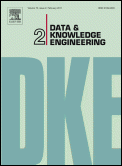Data & Knowledge Engineering
Appearance
 | |
| Discipline | Computer science |
|---|---|
| Language | English |
| Edited by | P.P. Chen |
| Publication details | |
| History | 1985–present |
| Publisher | |
| Frequency | Monthly |
| 1.500 (2015) | |
| Standard abbreviations | |
| ISO 4 | Data Knowl. Eng. |
| Indexing | |
| CODEN | DKENEW |
| ISSN | 0169-023X (print) 1872-6933 (web) |
| LCCN | 90649274 |
| OCLC no. | 630595125 |
| Links | |
Data & Knowledge Engineering is a monthly peer-reviewed academic journal in the area of database systems and knowledge base systems. It is published by Elsevier and was established in 1985. The editor-in-chief is P.P. Chen (Louisiana State University).
Abstracting and indexing
The journal is abstracted and indexed in Current Contents/Engineering, Computing & Technology,[1] Ei Compendex,[2] Inspec,[3] Science Citation Index Expanded,[1] Scopus,[4] and Zentralblatt MATH.[5] According to the Journal Citation Reports, the journal has a 2015 impact factor of 1.5.[6]
References
- ^ a b "Master Journal List". Intellectual Property & Science. Clarivate Analytics. Retrieved 2017-02-14.
- ^ "Content/Database Overview - Compendex Source List". Engineering Village. Elsevier. Retrieved 2017-02-14.
- ^ "Inspec list of journals" (PDF). Inspec. Institution of Engineering and Technology. Retrieved 2017-02-14.
- ^ "Source details: Data and Knowledge Engineering". Scopus preview. Elsevier. Retrieved 2017-02-14.
- ^ "Serials Database". Zentralblatt MATH. Springer Science+Business Media. Archived from the original on 2017-11-07. Retrieved 2017-02-14.
- ^ "Data & Knowledge Engineering". 2015 Journal Citation Reports. Web of Science (Science ed.). Clarivate Analytics. 2016.
External links
